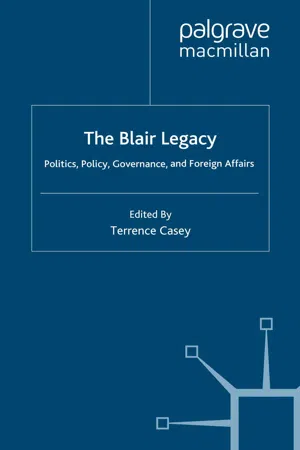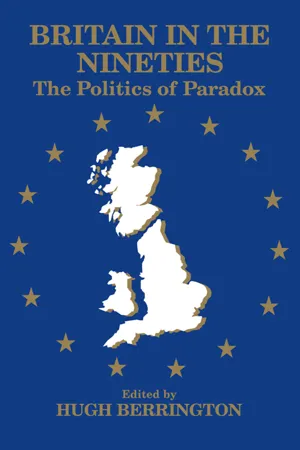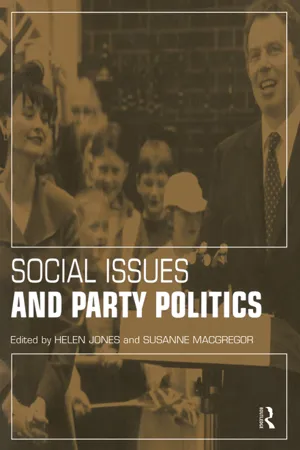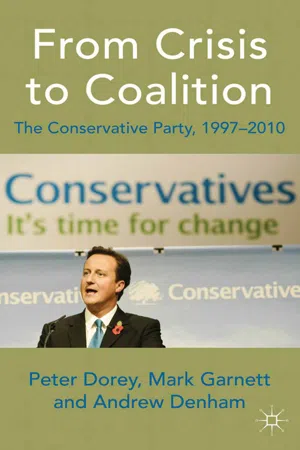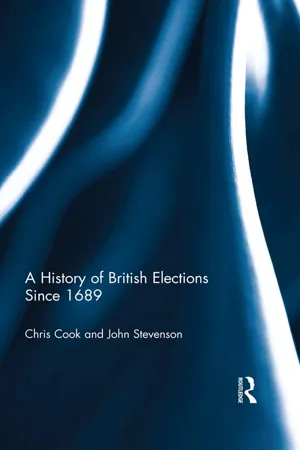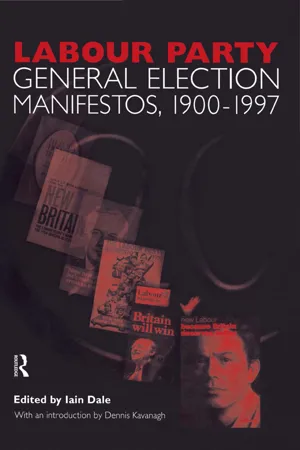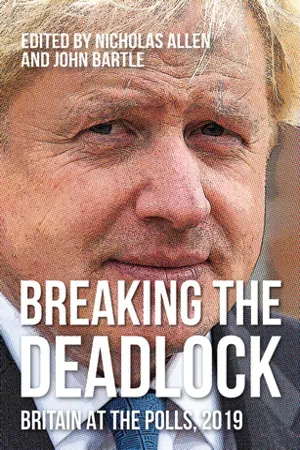History
1997 General Election
The 1997 General Election in the UK marked a significant political shift, with the Labour Party, led by Tony Blair, securing a landslide victory after 18 years of Conservative rule. This election saw the largest swing to a single party since 1945, leading to a major overhaul of policies and the beginning of a new era in British politics.
Written by Perlego with AI-assistance
Related key terms
1 of 5
8 Key excerpts on "1997 General Election"
- eBook - PDF
The Scottish Electorate
The 1997 General Election and Beyond
- A. Brown, D. McCrone, L. Paterson, Paula Surridge(Authors)
- 1998(Publication Date)
- Palgrave Macmillan(Publisher)
2 The 1997 General Election: Background, Campaign, Results, Consequences INTRODUCTION The morning after the 1997 General Election in Scotland stands in sharp contrast to that following the election in 1992. After a campaign that seemed to have lasted for the intervening five years, people in Scotland woke up to the news not just of a Labour victory and a record majority in the House of Commons, but to the fact that not one candidate from the Conservative Party had been elected to represent a Scottish constituency. While a Tory wipe-out was predicted by a few more foolhardy commentators in 1992, no such speculation was being made in 1997 in spite of evidence from the opinion polls showing the Conservatives in a very weak position and the fact that the party had performed badly in the European and local elections in 1995. Indeed there was a cautious air about the pre-election predictions in Scotland. The memory of 1992, when the Conservatives actually increased their percentage vote and number of seats in Scotland, still haunted those who had looked forward to a change of government. The reason for this caution can be explained partly by the central role of the constitutional question in Scottish politics and by the belief that so much was at stake. For political opponents of the Conservatives, the object was not just to replace the government but to have an opportunity to fulfil some of the hopes and aspirations for home rule in Scotland. 26 The Scottish Electorate This chapter outlines the background to the election campaign before assessing the results of the election and the consequences for Scottish and British politics. In Chapter One we identified four key dates in Scottish political history prior to 1997, namely 1832, 1886, 1922 and 1974. - eBook - PDF
The Blair Legacy
Politics, Policy, Governance, and Foreign Affairs
- T. Casey(Author)
- 2009(Publication Date)
- Palgrave Macmillan(Publisher)
Blair was fortunate that he inherited the leadership at a time when the Conservatives were deeply unpopular. The 1994 European Parliament election was held in the interregnum between Smith’s death and Blair’s accession and proved a triumph for Labour, the party taking 44.2 per cent of votes across Britain and 62 (of 84) seats. The Conservatives, in con- trast, won just 27.9 per cent of votes and 18 seats – at that point their small- est vote share in any national election during the twentieth century (Mortimore, 1994). There was a similar story in local elections. In 1993 the Conservatives lost almost 500 councillors in the shire counties (although the Liberal Democrats benefited to a greater extent than Labour) and the pattern of heavy Conservative losses was repeated in the 1994 local contests held while Smith was still party leader. 1 Nonetheless, as measured by opinion polls, the impact of Blair on Labour’s popularity and electoral prospects can only be described as electric. From his accession through to the 1997 General Election, Labour’s share of voting intentions never fell below 50 per cent and he easily outscored his rivals as the best person to be prime minister. Over the 32 months from August 1994 to March 1997 Blair was preferred on average by 41 per cent of electors compared with 19 per cent for Major. In this respect, Blair’s personal ascendancy was a central fact – perhaps the central fact – of British politics from 1994 onwards. Landslide: The 1997 General Election By any standard Labour’s victory in the 1997 General Election was a remark- able achievement. Having come close to being written off just five years pre- viously, the extent of Labour’s success was astonishing (see Table 1.1). The swing from the Conservatives to Labour at 10 per cent was almost double the post-war record. Labour’s haul of 418 seats was the largest ever won by the party and its majority over all other parties (177), the largest for any gov- ernment since 1935. - eBook - ePub
Britain in the Nineties
The Politics of Paradox
- Hugh Berrington(Author)
- 2014(Publication Date)
- Routledge(Publisher)
potentially more volatile than in the past. The fact that this potential had not been fully realised did not mean that it did not exist.1992–97: DEALIGNMENT VINDICATED?In terms of the trends in party support, the period between the 1992 and 1997 elections was extraordinary. A slump in the popularity of the governing party, followed by a recovery as the next election approaches, is a familiar aspect of the inter-election cycle in Britain (as elsewhere) but the 1992–97 cycle set new records. The Conservatives experienced their worst-ever local election defeats, received their lowest vote share of the century in a national election (27.9 per cent) in the election to the European Parliament in June 1994, and lost all eight of the seats they defended in parliamentary by-elections. In the monthly opinion polls, the Conservative share of voting intentions plunged further and faster than ever before and the gap between the government and the opposition was larger and longer-lasting than in any previous cycle. Between 1987 and 1992, for example, Labour had led the Conservatives by more than ten per cent for 12 months; between 1992 and 1997 Labour’s lead was more than 20 per cent for 39 months. On the basis of previous experience, politicians and pundits waited expectantly for the gap to narrow significantly as the 1997 election approached, but it never did. Although the Conservatives recovered a little from their truly disastrous poll ratings in early 1995, they never looked like threatening Labour’s lead and were still 25 points behind in March 1997.During this cycle the Conservatives lost three of the significant electoral advantages that they had previously enjoyed. The first was in terms of leaders. Although John Major had been preferred by the electorate over Neil Kinnock, he soon came to be seen as weak and indecisive. In July 1992 Kinnock was replaced as Labour leader by John Smith. Within three months, Smith overtook Major as the most preferred prime minister, and over his 21-month term as leader he was preferred, on average, by 32 per cent of Gallup’s respondents, compared with 22 per cent for Major and 20 per cent for Paddy Ashdown, leader of the Liberal Democrats. Following John Smith’s death, Tony Blair became Labour leader in July 1994. Almost as soon as Blair was elected, he established a commanding lead over his rivals as the party leader thought likely to make the best prime minister. From August to December 1994 he was preferred on average by 41 per cent of the ‘Gallup 9000’ compared with 16 per cent for Major and 14 per cent for Ashdown. During the next 12 months the average figures were 42 per cent for Blair, 17 per cent for Major and 13 per cent for Ashdown, while for 1996 they were 39 per cent for Blair, 19 per cent for Major and 14 per cent for Ashdown. For the first time for many years the Conservatives faced a general election with a leader who was much less popular with the electorate than his main rival. - eBook - ePub
- Helen Jones, Susanne MacGregor(Authors)
- 2005(Publication Date)
- Routledge(Publisher)
Chapter 1The road to 1997
Helen JonesTHE SUN SHINES ON BLAIR
On 17 March John Major, and on 2 May Tony Blair, provided the 1997 General Election with a symbolic stage-managed symmetry. John Major, following a format he instigated in 1992, stood alone and isolated in Downing Street to announce 1 May as Polling Day. He used the occasion to launch the formal campaign (a phoney one had been underway for at least a year) with a party-political plea for the Conservatives. Six and a half weeks later Tony Blair walked up Downing Street (the formality and separation from the people of an official car abandoned) with a youthful and apparently happy family to the cheers and flag-waving of hand-picked party workers. These strong and contrasting images—of John Major, formal and isolated from party and people and Tony Blair, informal and surrounded by loyal supporters—were present throughout the campaign. Both parties put enormous effort into trying to control the media's presentation of their leaders. Labour succeeded, but the Conservatives failed miserably, not least because the bulk of newspapers were no longer, as in previous General Elections, the willing accomplices of the Conservative Party.The way in which the parties presented their leaders and aimed to control the media affected the conduct of the campaign which some commentators believed signalled the growing ‘Americanisation’ of British elections with a more presidential style campaign, focusing on the leader, not the party. A live TV debate between candidates for the Presidency is an accepted event in American elections. Negotiations (conducted in private between Lord Irvine for Labour and Michael Dobbs for the Conservatives and slogged out in public between Peter Mandelson and Brian Mawhinney) to present a live TV debate between John Major and Tony Blair became a part of the campaign, foundering largely on the ‘Paddy problem’, that is, what role Paddy Ashdown, leader of the Liberal Democrats, should play. The Conservatives paid a man to dress up in a yellow chicken suit with a placard ‘Chicken Blair Won't Debate’ to chase Blair until he agreed to a live TV debate. (This was another echo of the 1992 presidential campaign.) The chicken spawned a whole zoo of animals posing for photographers, but it did little to leaven the Conservatives' gloom. - eBook - PDF
From Crisis to Coalition
The Conservative Party, 1997-2010
- P. Dorey, M. Garnett, A. Denham(Authors)
- 2011(Publication Date)
- Palgrave Macmillan(Publisher)
The 1997 General Election result only confirmed what most observers had known for some time – namely, that Labour had expunged the most pressing reasons for its electoral failures since 1979, exposed the inherent weakness in the position of its chief opponents, and thus re-established itself as a serious player for years to come. For all Cameron’s achievements, only after the next election will it be possible to decide whether or not the Conservatives have truly recovered from their own mistakes and the challenge posed by New Labour. Although they are the dominant force within the coalition formed in May 2010 it is still possible to argue that they remain a party in crisis, more than two decades after Margaret Thatcher was removed from office. Notes 1. Dennis Kavanagh and Philip Cowley , The British General Election of 2010, Basingstoke, Palgrave Macmillan, 2010, pp.159–61. 2. Conservative Party , Invitation to Join the Government of Britain: The Conservative Manifesto 2010, 2010, p.113. 3. Nicholas Watt, ‘There’s No Such Thing as “Big Society”’, Senior Tories Tell Cameron’, The Guardian, 20 April 2010. 4. Quoted in The Guardian, 8 May 210. The Conservatives in the 2010 General Election, and its Aftermath 197 5. See, for example, ConservativeHome, Falling Short: The Key Factors that Contributed to the Conservative Party’ s Failure to Win a Parliamentary Majority , 2010, p.13; . 6. Ipsos MORI Political Monitor, March 2010. 7. . 8. David Denver, ‘The Results: How Britain Voted’, Parliamentary Affairs, 63.4 (2010), p.591. 9. Nicholas Jones, Campaign 2010: The Making of the Prime Minister, London, Biteback Books, 2010, p.315. 10. . 11. Ibid. 12. Justin Fisher, ‘Party Finance: Normal Service Resumed?’, Parliamentary Affairs 63.4 (2010), p.790. - eBook - ePub
- Chris Cook, John Stevenson(Authors)
- 2014(Publication Date)
- Routledge(Publisher)
For the Liberals themselves, the election was an unmitigated disaster: their representation in Parliament was reduced from nine MPs to six; their plight was surpassed only by that of the Communist Party which received a derisory 0.07 per cent of the poll. Once again, the results could be claimed as a moral victory for both the major parties. The Conservatives had won a majority of parliamentary seats contested; the Labour Party, though defeated, had won more votes than ever before and for the third time since the war had secured more votes in an election than the Conservative Party.The election also marked a period of two-party electoral politics in Britain that was to last until the 1970s. As Table 7.1 shows, from 1951 to 1970 the vote of the two main parties never fell below 87.5 per cent.Table 7.1 Major vs. minor parties’ share of votes and seats, 1951–70Con. and Lab. combined Third and minor parties Year % of total vote % of total vote % of total vote % of total vote 1951 96.8 98.6 3.2 1.4 1955 96.1 98.6 3.9 1.4 1959 93.2 98.9 6.8 1.1 1964 87.5 98.6 12.5 1.4 1966 88.8 97.8 11.2 2.2 1970 89.4 98.1 10.6 1.9 Source: Butler, British General Elections, 79 .Given the strength of the Labour vote from 1945 to 1951, few could have realised that the 1951 election would inaugurate a long period of 13 years of Conservative rule during which Labour suffered serious infighting and the Liberals (at least until the Orpington by-election of 1962) remained on the fringes.The General Election of 1955
The background
The Conservatives entered the 1955 election against a background of many favourable conditions giving them cause for optimism. The resignation of Churchill as prime minister on 6 April 1955, and the succession of Sir Anthony Eden, provided the ideal opportunity to call a snap election against a background of rising living standards, an electioneering Budget and the end of the rationing of the immediate post-war years. Moreover the Conservatives could make much capital out of Nye Bevan’s resignation back in April 1951 – pointing to the (unlikely) scenario of the Bevanites taking control of the Labour Party.Moreover, the by-elections of 1951–55 had indicated popular support for the Conservatives. Not a single one had been lost by the Government since 1951, and South Sunderland had been gained from Labour in 1953. The 1955 municipal elections had produced good results for the Government and the opinion polls showed a majority in favour of continuing Conservative rule. The election campaign was the quietest and most uneventful in recent history. With the Conservative programme United for Peace and Progress - Dennis Kavanagh, Iain Dale, Iain Dale, Iain Dale Nfa(Authors)
- 2015(Publication Date)
- Routledge(Publisher)
LABOUR PARTY GENERAL ELECTION MANIFESTO 1987Britain will win with Labour
Date of Election Thursday 11 June Party Leader Neil Kinnock Candidates 633 MPs 229 Votes 10,029,778 % of Vote 31.7% Introduction by the Leader of the Labour Party
Every election is a time of decision. But this General Election on June 11 faces the British people with choices more sharp than at any time in the past fifty years.The choices are between Labour’s programme of work for people and Tory policies of waste of people: between investment in industrial strength, and acceptance of industrial decline; between a Britain with competitive, modern industries, and a Britain with a low tech, low paid, low security economy increasingly dependent upon imports.The election will decide whether we and our children are to live in a country that builds high standards of care for all who need treatment for illness, pensions in retirement, good grounding in education, fair chances to get on; or in a country where the Conservatives go on running down the vital health, education and social services of every community, imposing higher charges and lower standards.This election will decide whether our country is to be a United Kingdom or a divided kingdom; one that is brought together by proper provision, prudent investment and concern for the interests of the whole nation, or one that is pulled apart by poverty, cuts, increased privilege for the richest and neglect for the rest.This election will decide whether we put our resources into the real defence provided by a modern, well-equipped army, navy and airforce safeguarding our country and supporting NATO; or spend those sums on maintaining an ageing system of nuclear weapons, while buying a new generation of missiles which cannot give our country effective defence. It will decide whether Britain is part of the international process of nuclear build-down or ruled by a government uniquely intent upon nuclear build-up.- eBook - ePub
Breaking the deadlock
Britain at the polls, 2019
- John Bartle, Nicholas J. Allen, John Bartle, Nicholas J. Allen(Authors)
- 2021(Publication Date)
- Manchester University Press(Publisher)
6 Academics agree that there has been a fundamental shift in the relationship between both attitudes and demographics and vote choice. Put simply, vote choice used to be strongly structured by a primary traditional left–right axis that was rooted in social class and in turn shaped traditional partisan alignments. That pattern has now changed. Cultural, or second-dimension, issues are now more important than before and rooted in different demographics (age, education). Labour has lost a great deal of support in its traditional working-class constituencies and communities as a result.Why might we think 2019 was a critical election, and why is this question being posed? The answer lies in the 2019 general-election campaign and in the result. It was the election to ‘get Brexit done’, the election that finally delivered the Conservatives a comfortable parliamentary majority, the election where many of Labour’s traditional heartland seats fell dramatically to the Conservatives and the election where – in a stunning reversal – more working-class voters supported the Conservatives than Labour.7 It was also the election that finally made possible Britain’s withdrawal from the EU, and in doing so delivered Brexit.In this chapter I set out a framework for thinking about whether the 2019 general election can be viewed as a critical election. I first consider what we mean by a critical election. I then summarise the evidence for an electoral realignment, and – as a result – argue that 2017 and 2019 were both critical elections that together resulted in a realignment. These elections were two steps in a process through which Brexit reshaped the electorate. The preconditions for this realignment were helped by the long-term shifts in the electorate, but these were not sufficient to make a major realignment inevitable. For there to be an electoral realignment, the mainstream parties had to compete around a ‘second dimension’ in British politics, which they ended up doing because of the importance of disagreements about Europe. Brexit, the pre-eminent cultural, or second-dimension, issue, realigned and sorted the electorate along party lines. Insofar that 2019 was a critical election, its main consequence was to increase party sorting among those voters who had backed Leave in the referendum – but not among those who had backed Remain – which benefited the Conservatives and contributed to their large parliamentary majority, as Robert Johns describes in Chapter 6. Whether this asymmetric realignment is likely to be a continued feature of British politics remains to be seen. The political parties must navigate this new electoral configuration in which the second dimension of political competition has created new electoral coalitions, accentuated geographic divides and altered Britain’s electoral geography. All of this has taken place in the context of an increasingly volatile electorate that has the potential to be move volatile in future.8
Index pages curate the most relevant extracts from our library of academic textbooks. They’ve been created using an in-house natural language model (NLM), each adding context and meaning to key research topics.

